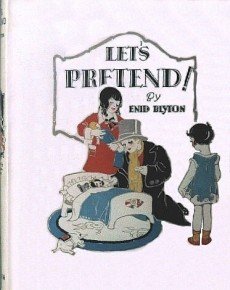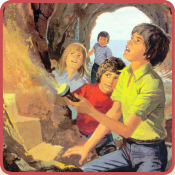
Let's Pretend!

Book Details...
First edition: 1928
Publisher: Nelson
Illustrator: I. Bennington Angrave
Category: One-off Novels
Genre: Family
Type: Novels/Novelettes
Publisher: Nelson
Illustrator: I. Bennington Angrave
Category: One-off Novels
Genre: Family
Type: Novels/Novelettes
On This Page...
At present these are just the illustrations from a scarce book that has never been reprinted.

Front Cover


Endpapers
A few year's ago I was half-listening to a quiz on the radio about children's authors and their books. I pricked up my ears when I heard the quiz master say that the next round would be about Enid Blyton. The usual simple questions followed, and all received quick right answers. Then came the question, "How many books did she write in the first person?" There was a pause, before a member of the panel answered, "Well, surely, none!" "Right!" retorted the quiz master, "She wrote all her books in the third person." "Wrong!" I shrieked at the radio, and Barney who had been quietly dog-napping at my feet, leapt suddenly as I think he thought I had said another word beginning with a 'W'. He was out of luck!
Front Cover


Endpapers
Although Enid wrote one or two short stories in the first person, of the books that class as 'Novels' in the Cave of Books, just two were written in the first person, both in the late 1920s. Coincidentally in both cases the narrator of the story was a twin. It has been remarked upon before that Enid seemed to have a 'thing' about twins, as quite a few popped up in her books over the years, but I believe that it was simply one of her methods of introducing more children of a similar age into a story. Another way of doing this is to introduce cousins into the story, and the first of these books, The Wonderful Adventure, published by Birn Brothers in 1927, uses both ploys. The storyteller is ten year-old Mollie, who has a twelve year-old brother, Peter, her twin Jack and an eight year-old younger sister, Kitty. Add to this their cousins, Joan and Harry, who are nine and eleven respectively, and you have a group of six children all ready for adventure!
This review concerns the second of these books, Let's Pretend, published by Thomas Nelson in November 1928. There are just three children involved in this story, and two of them have the same names as children in the previous book. The ages are not stipulated, but the story would seem to imply that they are in the same sort of age group as the children in The Wonderful Adventure. The storyteller is Betty, who has a twin, Peter and a younger sister, Mollie. The fact that it was written in the first person, is not the only unusual thing about this book. To explain more fully, and also for the benefit of those who have not seen any Journals, I will recap on some of the things I wrote about it nine years ago in Journal 10.
When this book was published, Enid recorded in her diary that '...it is lovely, very artistic'. However she can't have been that surprised at the artwork as all 16 plates had appeared in a picture book with the same title which was published in June 1927, over a year earlier! One can only surmise that the publishers, Thomas Nelson, were so pleased with their 16 page picture book (no credits in it) that they decided to re-use the plates and asked Enid to write a story to go with them. In the resulting book the artist, I. Bennington Angrave, was given the credit that had been withheld in the earlier version. She also added a number of line drawings for chapter headings to the new book. The coloured illustrations had a sort of 'art deco' feeling to them and with a cover price of 10/6 it was certainly a lavish publication. To give some idea of a price comparison, Newnes 'Gift' books of the same period, such as The Enid Blyton Book of Fairies, were priced at 3/6, just a third of the price. Putting it further into perspective only one other book in our website 'Novels' section had a more expensive cover price and that was published twenty-four years later. I won't spoil it for trivia enthusiasts by naming the title! To the best of my knowledge, Let's Pretend was never reprinted and this makes it one of the scarcest Enid Blyton books, particularly in its original dustwrapper. Even without the dustwrapper it is a very nice book as it had a coloured picture embossed onto the cloth boards.
As might be expected from a story that is tailored to fit the illustrations, each chapter is somewhat episodic, in much the same way as Adventures of the Wishing-Chair. The basis of each chapter is some real life event that then inspires the children to retire to their nursery and re-enact their own version, occasionally with dire consequences. With no computers or televisions it was a time when children had to make their own entertainment. As seemed to be the trend in those days, their main contact with the adult world seems to be with Nurse rather than with Mummy. The action actually starts with a visit to Granny, who reads them a story from The Pirates of the Black Ship before they retire upstairs to a box-room where they dress up and act out their own version and in the process discover a box with a hidden compartment. It contains a pearl necklace that Granny had lost fifty years ago!
There are some nice period touches, such as Daddy getting into his 'holiday suit' to take them to the zoo, a visit subsequently cancelled when a telegram calls him back to the office. Compensation arrives in the form of Uncle Jack who takes them to the circus instead, and the 'pretend' that follows has Jingo their fox-terrier jumping through hoops, so successfully that at a later date an audience is invited in to raise money for children who can't walk.
Aunt Jill arrives with a Captain Manville who tells them tales about what he did in the Great War. They want him to pretend to be their Uncle and he rapidly becomes Uncle Bob after a swift proposal to Aunt Jill. A wedding follows in which Uncle Bob is unable to find the ring, but Betty our narrator comes to the rescue as she is still wearing a ring on her finger from an earlier pretend wedding. One must assume a certain passage of time occurs as in a later chapter Aunt Jill and Uncle Bob's baby features.
Poor Mummy succeeds in catching measles and gets a daily visit from Dr. Brown who stays for about twenty minutes on each occasion – now that really does date things a bit! This is too much for Nurse to handle and another nurse has to be specially employed, whilst Nurse gets on with Mummy's chores (whatever they are, as she also has help from Cook and Jane the maid).
Uncle Bob and Aunt Jill send a doll's house as a present (with some paint that Nurse confiscates, but it does get used later much to everybody's annoyance – even Gardener gets in on the act as his wheelbarrow gets painted!), but this sounds more like a Wendy house from the size of it. All the favourite doll's get places of prestige, but I don't think it would please the pc brigade that Darky, a little black doll, gets put in the kitchen to do the cooking – she is not alone though as she is given Golly for company!
All in all, it is an interesting look at life in a late 1920s middle-class household, and there are plenty of other episodes. I was amused in one that the children were allowed to use the 'electric cleaner' as a treat, presumably this was an early make of Hoover! If you are lucky enough to find a copy it is an entertaining read.








































































































































